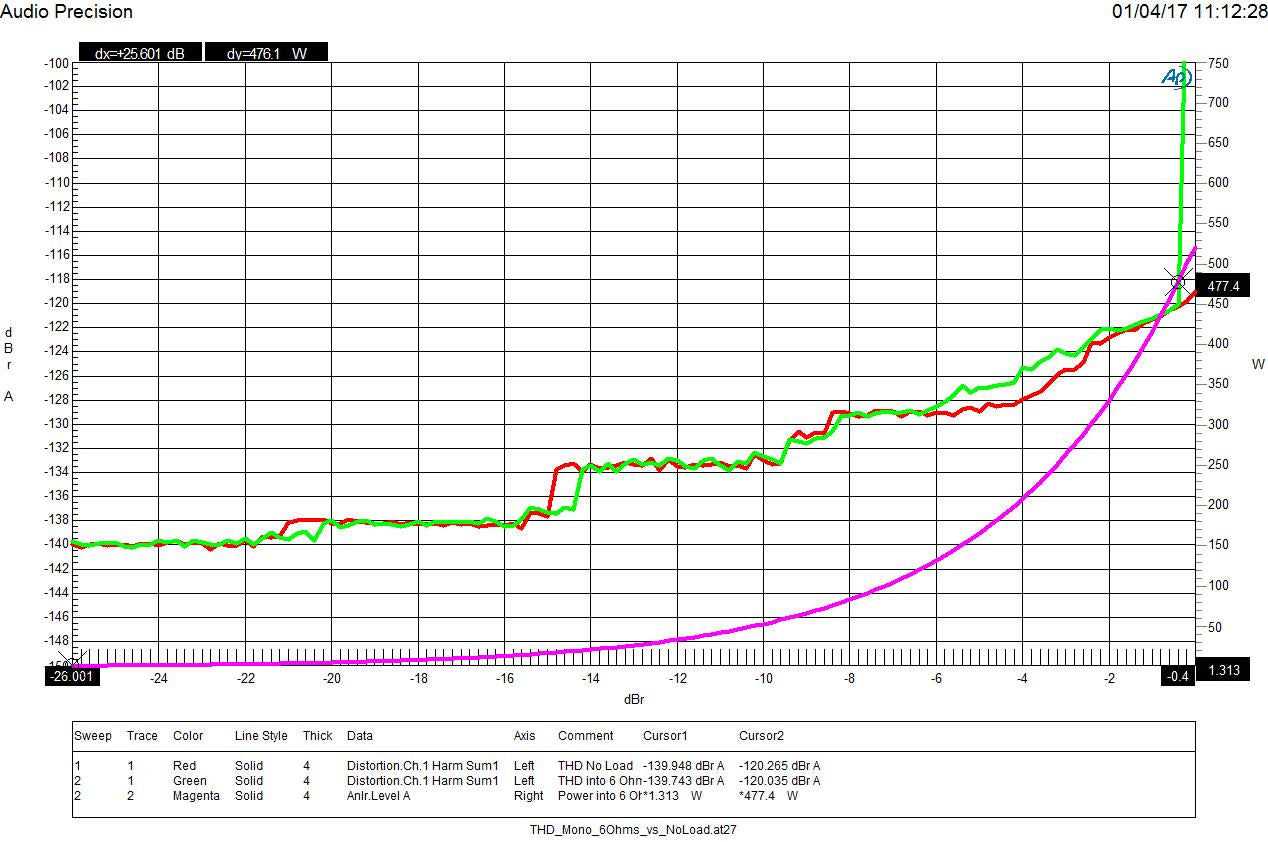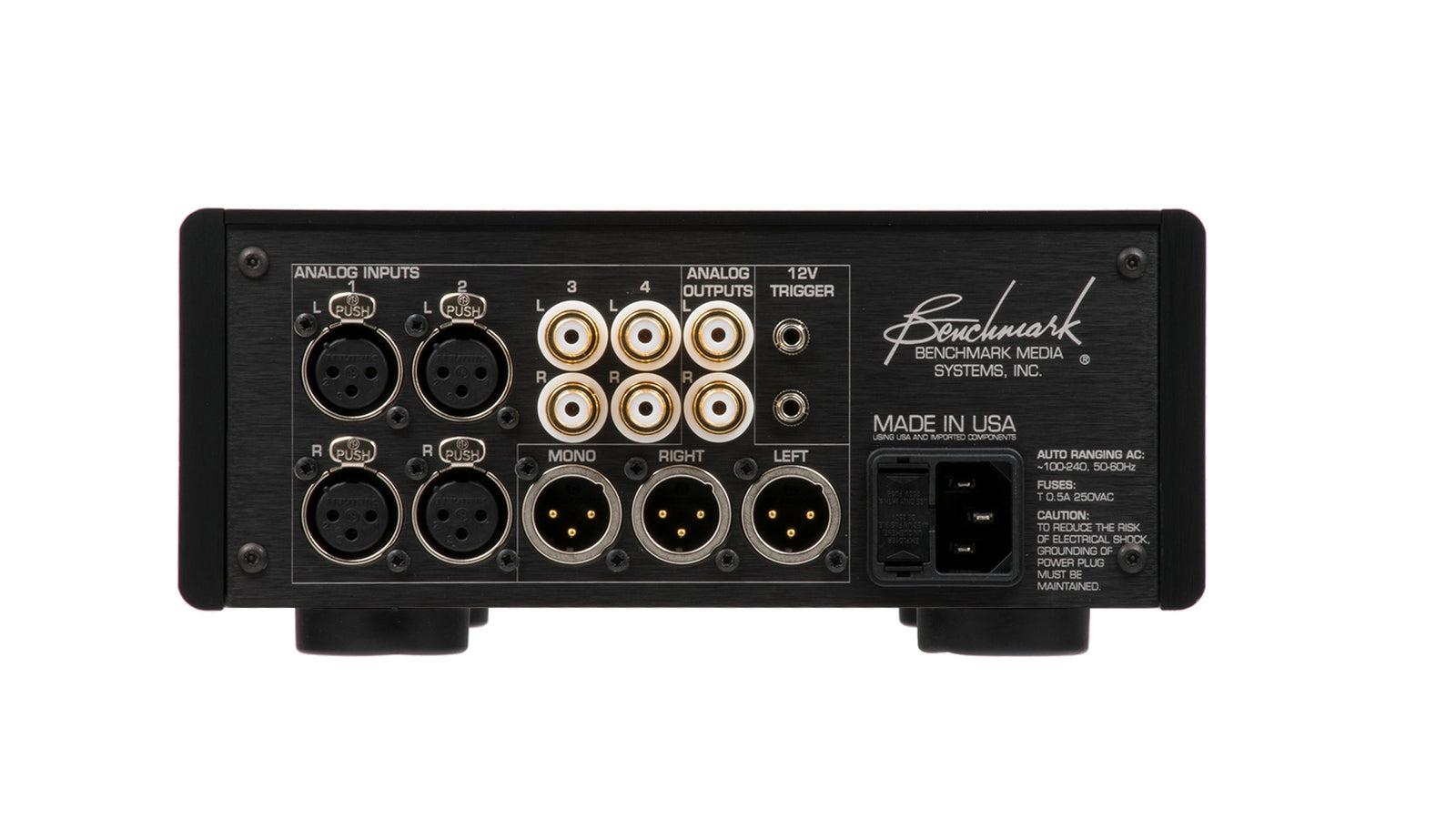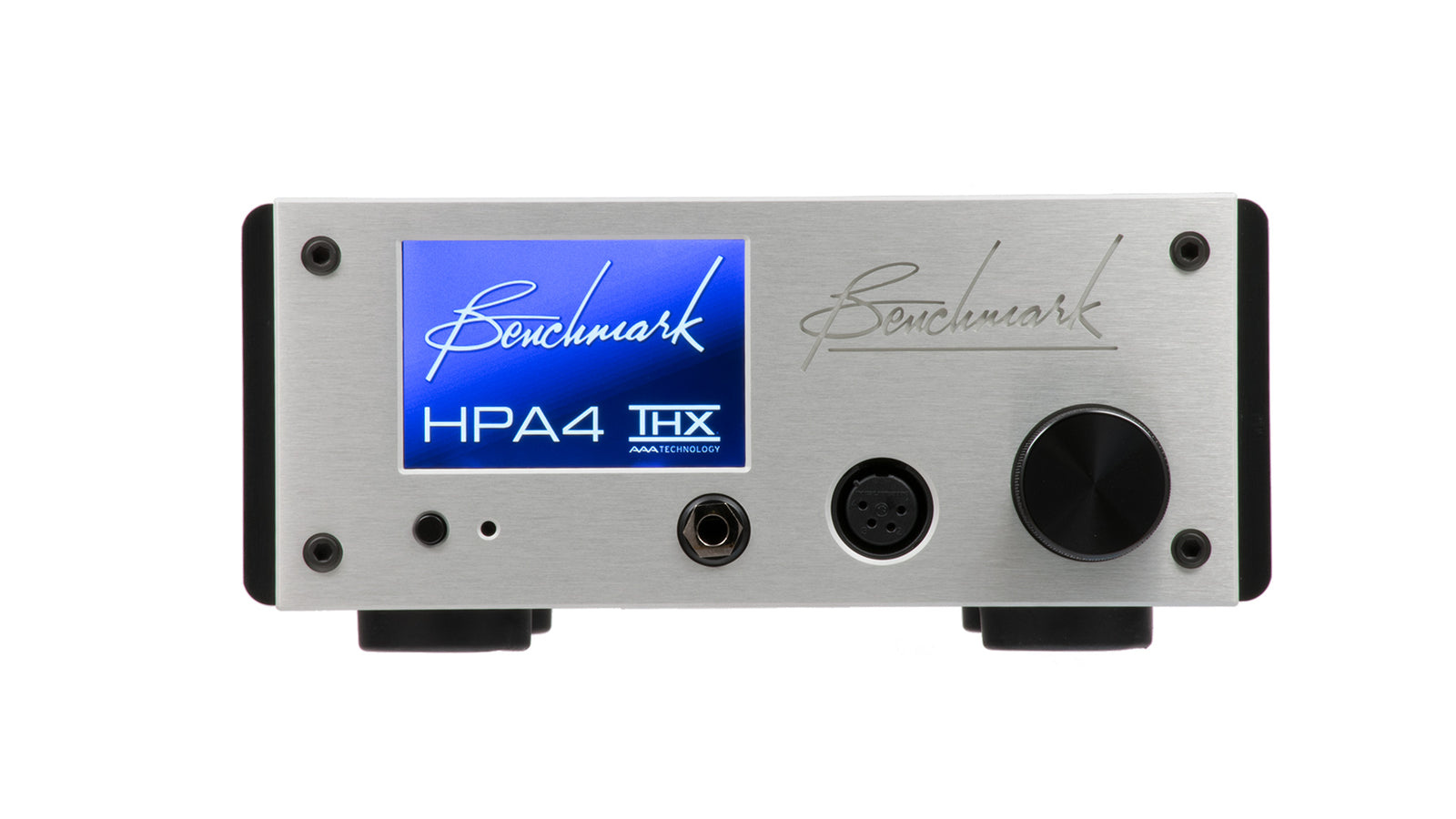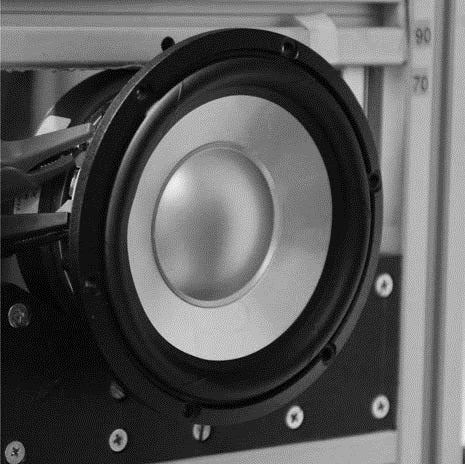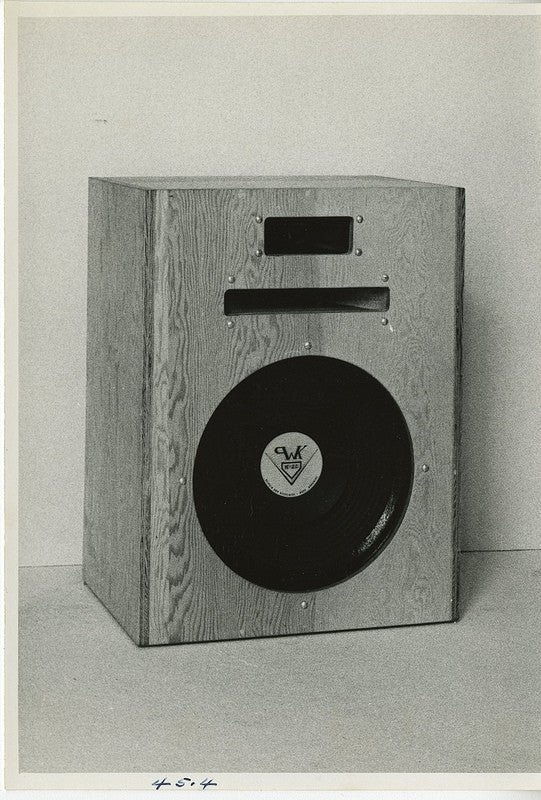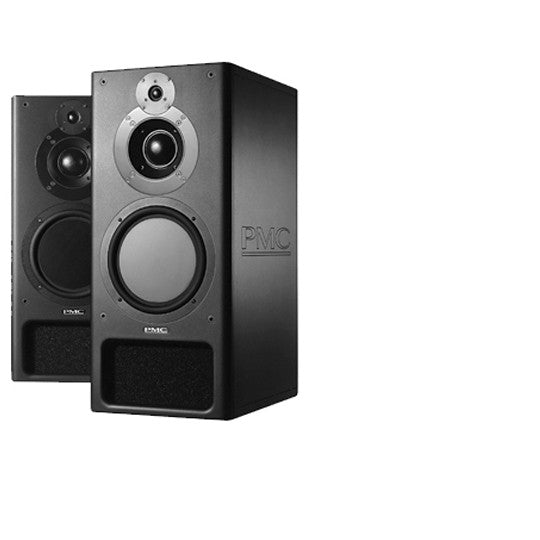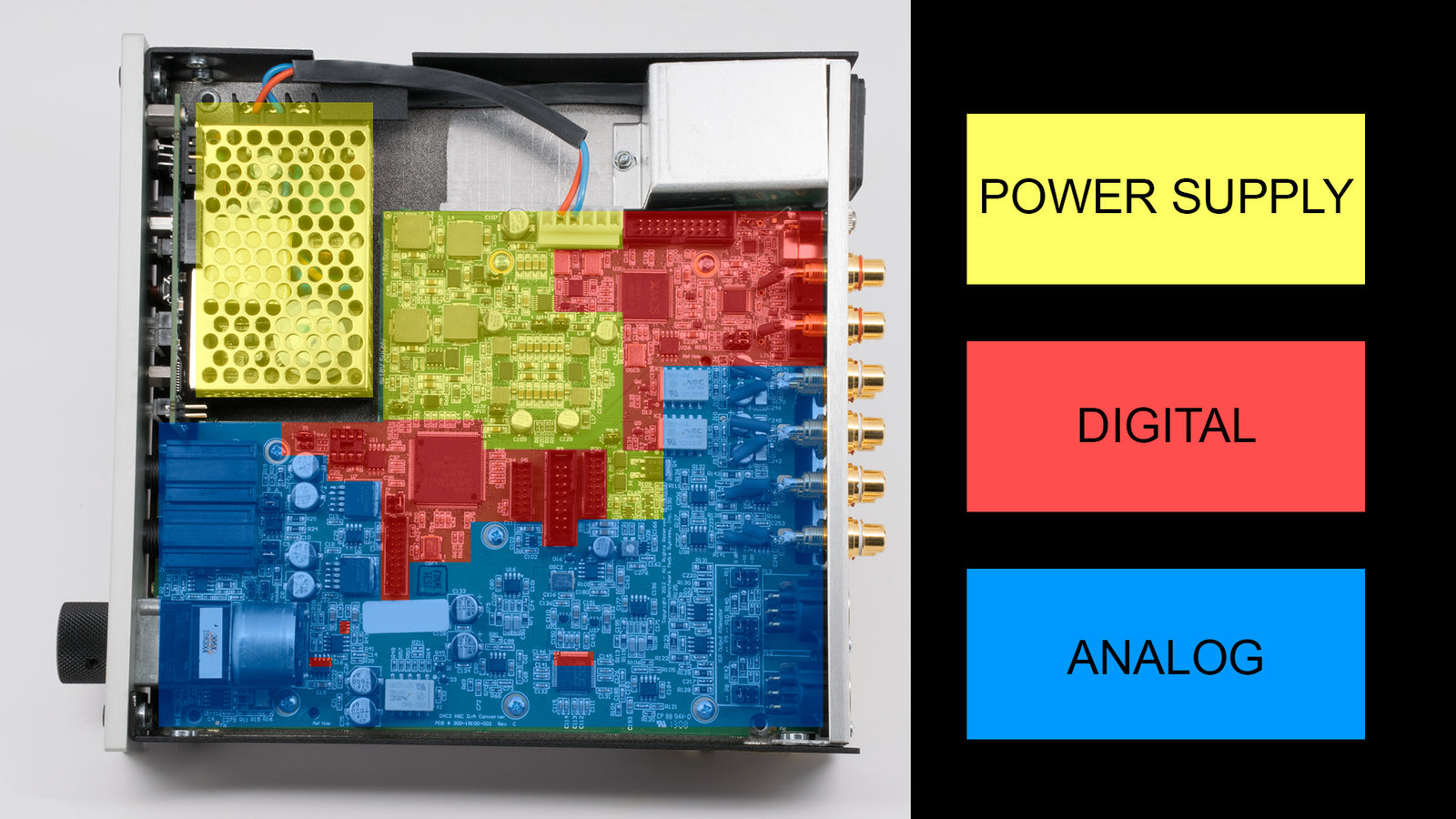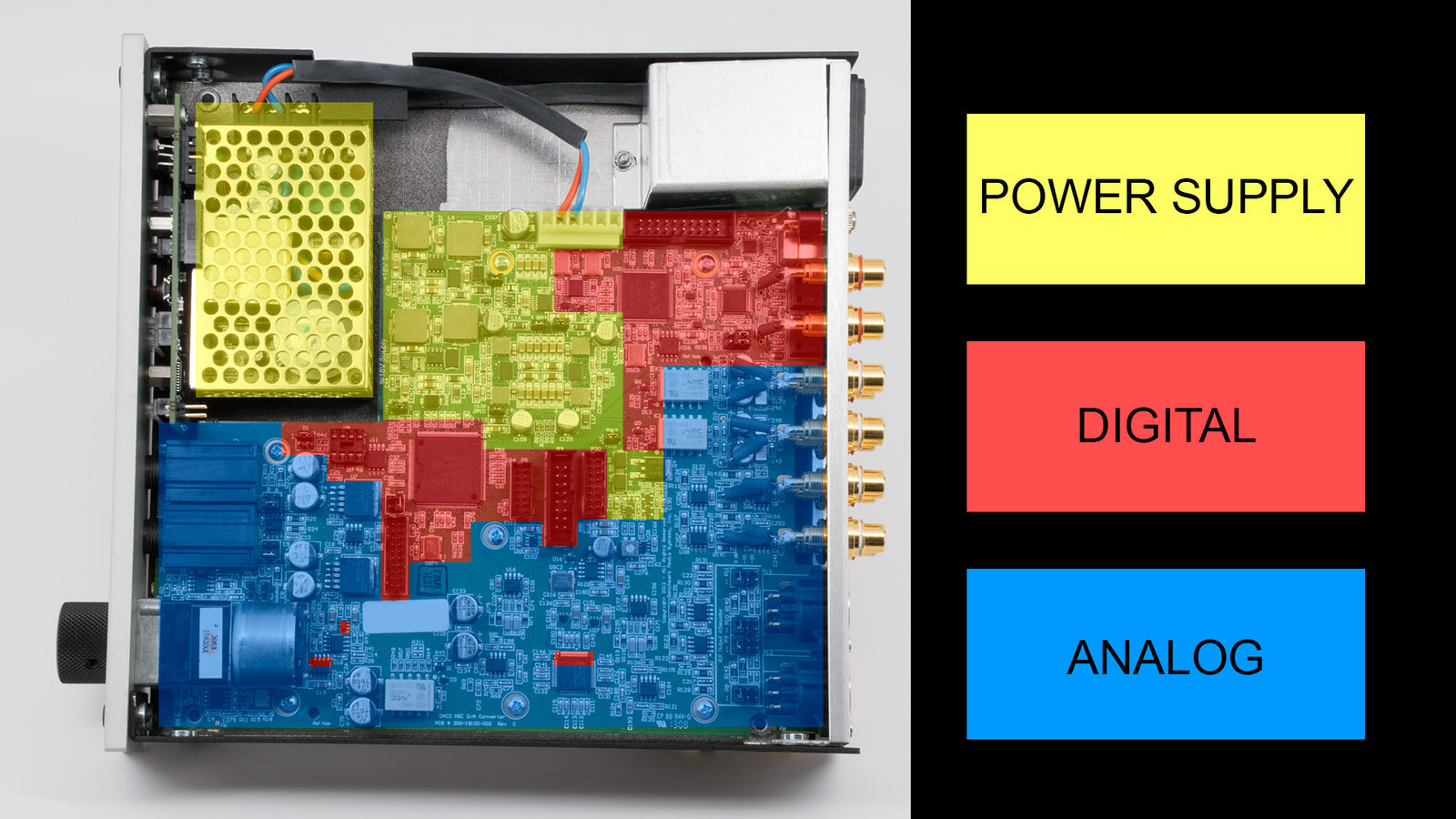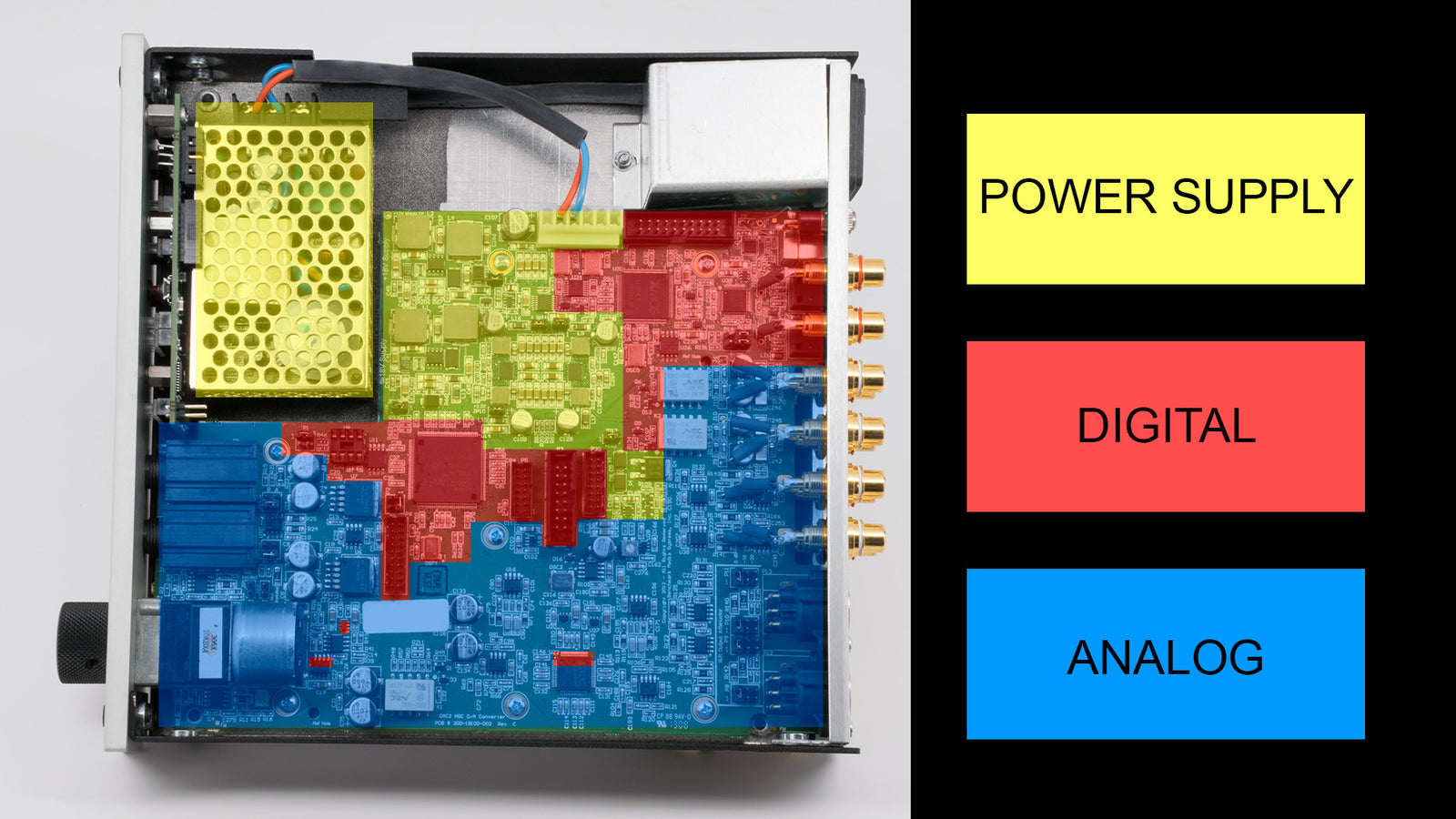Buy one component and save 10% on up to 2 cables. Buy 2 components and get 4 free cables. Free shipping on USA orders over $700.
Buy one component and save 10% on up to 2 cables. Buy 2 components and get 4 free cables. Free shipping on USA orders over $700.
Audio Application Notes
How Loud is the Distortion from Your Power Amplifier?
by John Siau August 08, 2025
Would you put a Washing Machine in your Listening Room?
If the answer is no, you may be surprised to discover that the distortion produced by your power amplifier may be louder than the noise produced by a major appliance.
Don't believe me? Take a look at Stereophile's test reports:
We selected 7 power amplifiers from Stereophile's top list of recommended amplifiers.
We took Stereophile's "THD+N vs. Power" plots for each, and replotted the data in a format that shows the loudness of the THD+N at the listening position.
The results are shocking!
Amplifier THD+N is louder than expected!
The distortion from your amplifier may be louder than a washing machine on the spin cycle, or it may be totally silent. How does yours perform? The answer is hidden in Stereophile's THD+N plots.
This application note reveals the hidden truth:
"The Distortion from your Power Amplifier may be Louder than a Washing Machine!"
I know, it sounds crazy, but this is what the measurements show!
Secrets Q&A with John Siau of Benchmark Media Systems
by Benchmark Media Systems January 07, 2022
Secrets contributor Sumit Chawla recently caught up with Benchmark’s VP and Chief Designer, John Siau to get a little more in-depth on several subjects.

Q: "Benchmark is one of the few companies that publishes an extensive set of measurements, but you also balance that with subjective testing. Can you talk about the equipment, the listening room, and the process for subjective testing?"
Q: "Was there ever a time where you learned something from a subjective test that was not captured by measurements?"
Q: "You conducted some listening tests to determine whether distortion in the “First Watt” was audible. What test material did you use for this, and what did you find?"
Q: "The AHB2 amplifier incorporates THX Audio Achromatic Amplifier technology. When and how did the partnership with THX come about?"
Q: "Linear power supplies have been and remain quite popular in high-end devices. You favor switch-mode power supplies. When and why did you make this switch?"
... and more!
Listening vs. Measuring
by John Siau November 09, 2020
At Benchmark, listening is the final exam that determines if a design passes from engineering to production. When all of the measurements show that a product is working flawlessly, we spend time listening for issues that may not have shown up on the test station. If we hear something, we go back and figure out how to measure what we heard. We then add this test to our arsenal of measurements.
Benchmark's listening room is equipped with a variety of signal sources, amplifiers and loudspeakers, including the selection of nearfield monitors shown in the photo. It is also equipped with ABX switch boxes that can be used to switch sources while the music is playing.
Benchmark's lab is equipped with Audio Precision test stations that include the top-of-the-line APx555 and the older AP2722 and AP2522. We don't just use these test stations for R&D - every product must pass a full set of tests on one of our Audio Precision test stations before it ships from our factory in Syracuse, NY.
Feed-Forward Error Correction
by John Siau October 11, 2018
The Benchmark AHB2 power amplifier and HPA4 headphone amplifier both feature feed-forward error correction. This correction system is an important subset of the patented THX-AAA™ (Achromatic Audio Amplifier) technology. It is one of the systems that keeps these Benchmark amplifiers virtually distortion free when driving heavy loads. It is also the reason that these amplifiers can support 500 kHz bandwidths without risk of instability when driving reactive loads.
This paper explains the differences between feedback and feed-forward systems. As you read this paper, you will discover that you already understand the benefits of feed-forward correction because you use it instinctively to improve a feedback system commonly found in your automobile. If feed-forward correction can improve your driving experience, it may also improve your listening experience!
- John Siau
Balanced vs. Unbalanced Analog Interfaces
by John Siau April 23, 2018
If you look at the back of any Benchmark product, you will find balanced XLR analog-audio connectors. As a convenience, we also provide unbalanced RCA connectors on many of our products. In all cases, the balanced interfaces will provide better performance.
We build our unbalanced interfaces to the same high standards as our balanced interfaces, but the laws of physics dictate that the balanced interfaces will provide better noise performance.
This application note explains the advantages of balanced interfaces.
- John Siau
Relay-Controlled Volume - The Ultimate Solution for Analog Audio
by John Siau April 11, 2018
Benchmark has introduced a new analog-to-analog volume control circuit that features a 256-step relay-controlled attenuator and a 16-step relay-controlled boost amplifier. The volume control has a +15 dB to -122 dB range in 0.5 dB steps and is a key component in the HPA4 Headphone / Line Amplifier.
Our goal was to produce an analog-to-analog volume control with the highest achievable transparency. We wanted to be able to place this volume control in front of our AHB2 power amplifier or in front of our THX-888 headphone amplifier board without diminishing the performance of either device. Our volume control would need to have lower distortion and lower noise than either of these amplifiers. Given the extraordinary performance of these THX-AAA amplifiers, this would not be an easy task!
This application note discusses the engineering decisions that went into the development of this new analog volume control circuit. The end result is a fully buffered volume control with a signal-to-noise ratio that exceeds 135 dB. THD measures better than the -125 dB (0.00006%) limits of our test equipment.
- John Siau
Laboratory Use of the Benchmark AHB2 Power Amplifier
by John Siau January 26, 2018
SEAS, a well-known manufacturer of high-quality loudspeakers, selected the Benchmark AHB2 as a key component for use in testing loudspeakers. They created an innovative test system that measures loudspeaker motor strength and moving mass with higher accuracy than previous methods. This new measurement system was documented in the December 2017 Journal of the Audio Engineering Society.
According to the AES paper, the SEAS team selected the Benchmark AHB2 for the following reasons:
"A Benchmark AHB2 amplifier is used, which has excellent signal-to-noise ratio and bandwidth, low output impedance, and is suitable for laboratory use (with advanced overload protection)."
The AHB2 was designed to outperform all competing power amplifiers in terms of noise and distortion. The result is an amplifier with unrivaled transparency.
Our goal was to create the ultimate amplifier for the enjoyment of music. It is nice to know that the AHB2 is also being used to test new and improved loudspeakers!
- John Siau
Interpreting THD Measurements - Think dB not Percent!
by John Siau November 15, 2017
Distortion measurements (THD, THD+N and IMD) are traditionally expressed in terms of percent. But what do 1%, 0.1%, 0.01% or 0.001% mean in terms of loudness or audibility?
If you are like most people you just know that 0.001% is the best of the three numbers listed above. If you are a well-trained geek you will recognize that each added leading zero represents a 20 dB improvement. 0.01% is 20 dB lower than 0.1% and 40 dB lower than 1%. The well-trained geek will convert % to dB in order to give meaning to these numbers.
When THD is expressed in terms of dB, we can easily determine how loud the distortion will be in our playback system.
Will my audio electronics produce audible distortion?
Will the distortion produced by my audio electronics be inaudible?
- John Siau
AHB2 Tri-Amp Setup - Ellery Coffman
by Benchmark Media Systems July 27, 2017
The following photos and system descriptions were provided to us by one of our customers, Ellery Coffman. He has put together an amazing system and has carefully treated his room with acoustic absorbers. Nicely done!
Hi Rory,
Thanks again for your help. For two speakers, it is truly unbelievable how real this tri-amp system sounds; it is nothing short of jaw dropping! It truly sounds better than the $200k+ setups I've heard in some of the high-end audio shops I've been to.
Post updated 10/8/2020
Speaker Sensitivity and Amplifier Power
by John Siau April 27, 2017
Speaker sensitivity is a measure of how loud a speaker will play at a given input power or at a given input voltage. Sensitivity is normally measured with a 1 watt power input or a 2.83 Vrms voltage input.
There have been many different speaker designs over the years and there are vast differences in speaker sensitivity. The speakers below have sensitivities ranging from about 85 dB to 109 dB.
- What are the power requirements?
- What are the implications for system noise?
- How loud will each play?
- Do they require different amplifiers?
- John Siau
Audio Myths - The Ultimate "Myth Buster" Video - Monty Montgomery, Xiph.Org
by John Siau March 14, 2017
Digital Show & Tell, Monty Montgomery, Xiph.org
Monty Montgomery takes us into the lab and uses a series of simple demonstrations to bust some very common myths about digital audio. Test your knowledge of digital audio. This video is fun to watch and easy to understand! Monty takes some difficult concepts and demonstrates them in a clear and simple manner.
Have doubts about Nyquist? Have a fear of stairsteps? Are you worried about ringing? Ever wonder what digital audio does to the timing of transients? This video is for you!
Myth - "Digital audio has stairsteps."
Myth - "Increased bit depths reduce the stairsteps."
Myth - "Analog tape has more resolution than digital audio."
Myth - "Dither masks quantization noise."
Myth - "Signals lower than one LSB cannot be reproduced."
Myth - "Digital filters make square waves and impulses ring."
Myth - "Digital systems cannot resolve timing between samples."
A Look Inside the New ES9028PRO Converter Chip and the New DAC3
by John Siau November 14, 2016
ES9028PRO D/A Converter Chip - Block Diagram and Test Report
This application note examines the differences between the ES9018 and the new ES9028PRO. It also compares the Benchmark DAC2 and DAC3 to demonstrate the performance improvements that can be achieved in a commercial product. It has been a little over 7 years since ESS Technology introduced the revolutionary ES9018 audio D/A converter chip. This converter delivered a major improvement in audio conversion and, for 7 years, it has held its position as the highest performing audio D/A converter chip. But a new D/A chip has now claimed this top position. Curiously the successor did not come from a competing company; it came from ESS. On October 19, 2016, ESS Technology announced the all-new ES9028PRO 32-bit audio D/A converter. In our opinion, ESS is now two steps ahead of the competition!
- John Siau
Calculating the Performance of an Amplifier-Speaker Combination
by John Siau November 01, 2016
Example 1 - PMC IB2S
In this application note we calculate the maximum output level and noise level produced by an amplifier/loudspeaker combination. Use this example for calculating the performance of your system.
At the 141st AES conference we demonstrated two Benchmark AHB2 monoblock power amplifiers driving a pair of 4-Ohm PMC IB2S studio monitors. These monitor are also available the PMC IB2SE hi-fi version.
In bridged mono, the AHB2 can deliver over 518 watts into each of these 4-Ohm speakers. This is a perfect match to PMC's 500 watt recommendation. The AHB2 easily provides the power, the output current, and the damping required by these low-impedance speakers.
"I am very impressed with the clarity and accuracy of these outstanding professional monitors. The Benchmark AHB2 and PMC IB2S are an absolutely killer combination!"
- John Siau, VP, Benchmark Media Systems, Inc.
Power Amplifiers - A "First Watt" ABX Test
by John Siau September 27, 2016
In Benchmark's listening room we recently demonstrated the importance of the first watt using two 100 watt stereo power amplifiers. One amplifier was a traditional class-AB amplifier, the other was Benchmark's AHB2 power amplifier with feed-forward error correction. Using a double-blind ABX test, we verified that there was a clearly audible difference when the amplifiers drove speakers at an output level of 0.01 watt.
- John Siau
Inside the DAC2 - Part 3 - Power Supplies
by John Siau July 13, 2016
The Benchmark DAC2 is an audio digital-to-analog converter. This application note explains the power supply configuration inside Benchmark's DAC2 D/A converter. In part 1 of this series we discussed the importance of the analog section of an audio converter. In part 2 we discussed the unique high-headroom digital processing chain inside the DAC2. The analog and digital systems each contribute toward Benchmark's overall goal of transparent musical reproduction, but this goal can only be reached when these systems are supported by a well-designed power supply system. In many cases, classic solutions (linear power supplies, line-frequency transformers, and large banks of capacitors) fail to deliver adequate performance. The DAC2 takes a radically different approach.
- John Siau
Inside the DAC2 - Part 2 - Digital Processing
by John Siau June 24, 2016
The Benchmark DAC2 is an audio digital-to-analog converter. This application note explains the proprietary digital processing inside Benchmark's DAC2 D/A converter. In part 1 of this series we made the case that 90% of the components in an audio converter are analog, and that about 90% of the "magic" happens in the analog processing. Nevertheless the 10% that is digital still makes an audible contribution to the sound of an audio D/A converter. This is especially true when the digital processing is complemented by a very pure and clean analog section. With a highly transparent analog section, some of the subtleties of the digital processing can become apparent.
Take a tour of the digital processing chain in the DAC2.
- John Siau
Inside the DAC2 - Part 1 - Analog Processing
by John Siau June 04, 2016
The DAC2 is an audio digital-to-analog converter. Most people focus on the word "digital" and assume that all of the "magic" happens in the digital processing, but nothing could be further from the truth! A look inside most audio converters would show that about 90% of the components are analog!
This application note takes a look at the analog processing in Benchmark's DAC2 D/A converter.
- John Siau
The PLL in your D/A Can Taint A/B Listening Tests!
by John Siau June 03, 2016
A/B and A/B/X listening tests are important methods of comparing two audio sources or two audio components. In the studio an engineer may want to switch an effect or EQ setting on and off to decide if it contributes positively to a mix. Hi-Fi enthusiasts may wish to compare audio components, signal sources and interconnects. The DAC1 and DAC2 converters have input selector switches that allow fast and easy switching between signal sources. Before attempting to conduct these tests, it is important to understand how these converters and their switches work. A/B tests using the DAC1 input selector can be very misleading. In contrast, A/B testing using the input selector on the DAC2 will produce reliable results. This application note provides guidance for conducting reliable A/B or A/B/X listening tests with your D/A converter.
- John Siau
Audio Myth - "Switching Power Supplies are Noisy"
by John Siau May 03, 2016
This Myth Goes Something Like This:
"Switching supplies are noisy."
"Linear power supplies are best for audio."
We disagree!
About 5 years ago, Benchmark stopped putting linear power supplies into our new products, and we replaced them with switching power supplies. We did this because linear supplies are too noisy. Yes, you read that correctly, linear supplies are noisy!
A well-designed switching power supply can be much quieter than a linear supply!
Find out why!
- John Siau
Benchmark ... The Measure of Excellence®
by Benchmark Media Systems March 19, 2016
A benchmark is a standard or point of measurement to which other things can be compared.
As our name implies, we are committed to excellence. Our products often define the current state-of-the-art in terms of audio performance.
Benchmark products are designed and built by audio enthusiasts. We are musicians, audiophiles and audio professionals who are passionate about audio quality. We also are passionate about the durability and build quality of our products. Most of our products are designed, assembled, tested, and shipped worldwide from our headquarters in Syracuse, NY, USA, where we have been for over 40 years.
Our goal is to build top-quality sonically-transparent products that you will enjoy for years to come.
- John Siau, VP, Benchmark Media Systems





